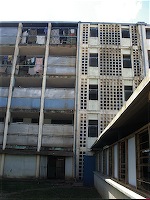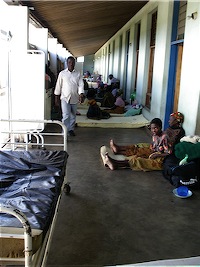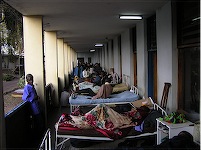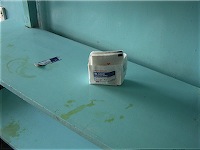Not All Days Bring Success
Editor’s Note: The following story played out in the largest hospital in the capital city of Lilongwe, Kamuzu Central Hospital. Reporting is Renee, a 3rd year Australian Medic Student. She had come to Malawi for the summer to work with the Malawi Project. Kamuzu Central Hospital (KCH), is a 1,000-bed, public tertiary care hospital operated by the MOH that serves a population of nearly four million persons.
 The sounds of a baby’s wails filled the air. He was obviously unwell. Only one month old, this tiny child was very wasted, with skin loosely hanging off stick-thin arms. His eyes were huge against his thin face. In sharp contrast, his abdomen was very distended, with loops of bowel clearly visible against his taut skin. Every time we pressed his stomach, he wailed more. His parents explained, fear in their eyes, that their child wasn’t feeding and hadn’t passed a bowel movement for six days. They had brought him in to the hospital when he started vomiting feculent matter. The stethoscope confirmed what was clinically obvious – we couldn’t hear any bowel sounds, proving that this tiny boy had an intestinal obstruction. Urgent surgery was needed. But this was Malawi, the third poorest nation on earth, and we would have to wait.
The sounds of a baby’s wails filled the air. He was obviously unwell. Only one month old, this tiny child was very wasted, with skin loosely hanging off stick-thin arms. His eyes were huge against his thin face. In sharp contrast, his abdomen was very distended, with loops of bowel clearly visible against his taut skin. Every time we pressed his stomach, he wailed more. His parents explained, fear in their eyes, that their child wasn’t feeding and hadn’t passed a bowel movement for six days. They had brought him in to the hospital when he started vomiting feculent matter. The stethoscope confirmed what was clinically obvious – we couldn’t hear any bowel sounds, proving that this tiny boy had an intestinal obstruction. Urgent surgery was needed. But this was Malawi, the third poorest nation on earth, and we would have to wait.
The baby began to vomit up a bright yellow bile-stained liquid. We quickly put him on an examination table, laying him on his side so that he wouldn’t breathe in his own vomit. The young doctor threaded a clear plastic tube through the boy’s nose to his stomach in the hope of removing some of the fluid. At first it appeared successful – bright yellow liquid flowed out of the tube and into a waiting bottle, but without any suction the flow soon stopped. It wasn’t long before the fluid began dribbling out of his mouth and nose once more. The doctor hurried off to fetch the head of surgery, leaving one nurse and me to look after the tiny boy. I couldn’t help but feel overwhelmed – in Australia, emergency specialists and experienced pediatricians would be crowding around this baby, doing everything possible to save his life. Here in Malawi, I was alone with a very ill child with nothing but a scrap of fabric to clear his mouth. I cradled his tiny head in my hand as I fought to remove the liquid from his mouth and keep his airways open, but there was little I could do. The cloth the tiny boy was lying on became soaked in fluid. He stopped wailing and began to draw gasping, gurgling breaths as the liquid went down his airways and into his lungs. His tongue and lips started to turn blue. We tried to get a machine to read what the levels of oxygen were in his blood, but he was too cold for the machine to work. We piled blankets on top of him and tried again, but still no luck. The doctor returned and told us that the surgeon still had four more patients to see, but would come as soon as he could. All that I had read about the understaffing crisis in Malawi hospitals suddenly hit home. I showed the doctor the child’s blue lips and asked for a tube to be put down the baby’s windpipe to keep his airways open. If the worst happened and the baby stopped breathing, this tube would also allow us to breathe for him. The doctor agreed and left to get an anesthesiologist to put the tube in. Meanwhile, the nurse worked desperately to place a needle in the boy’s veins so that we could put some fluid into his bloodstream and re-hydrate him. She asked me to clamp my hand tightly around the baby’s upper arm so she could find a vein – not even one tourniquet was available in the entire ward. My hand easily encircled his thin little arm, but the nurse couldn’t find a vein. The same thing happened when she tried his left side. Things were getting desperate. The nurse pulled out a small blade and shaved one side of the baby’s head. His soft black curls fell to the floor, exposing his scalp veins. But he was so dehydrated that even these veins had collapsed, and the nurse was unsuccessful once again. The doctor returned for the second time, said the anesthesiologist was on his way, and ordered that the baby be immediately transferred to the high dependency unit of the paediatric ward. His mother scooped him up and cradled him as we all moved into HDU. The eyes of all the parents in the crowded paediatric ward followed us as we left. I know they were all thinking the same thing: thank God that’s not my child.
plastic tube through the boy’s nose to his stomach in the hope of removing some of the fluid. At first it appeared successful – bright yellow liquid flowed out of the tube and into a waiting bottle, but without any suction the flow soon stopped. It wasn’t long before the fluid began dribbling out of his mouth and nose once more. The doctor hurried off to fetch the head of surgery, leaving one nurse and me to look after the tiny boy. I couldn’t help but feel overwhelmed – in Australia, emergency specialists and experienced pediatricians would be crowding around this baby, doing everything possible to save his life. Here in Malawi, I was alone with a very ill child with nothing but a scrap of fabric to clear his mouth. I cradled his tiny head in my hand as I fought to remove the liquid from his mouth and keep his airways open, but there was little I could do. The cloth the tiny boy was lying on became soaked in fluid. He stopped wailing and began to draw gasping, gurgling breaths as the liquid went down his airways and into his lungs. His tongue and lips started to turn blue. We tried to get a machine to read what the levels of oxygen were in his blood, but he was too cold for the machine to work. We piled blankets on top of him and tried again, but still no luck. The doctor returned and told us that the surgeon still had four more patients to see, but would come as soon as he could. All that I had read about the understaffing crisis in Malawi hospitals suddenly hit home. I showed the doctor the child’s blue lips and asked for a tube to be put down the baby’s windpipe to keep his airways open. If the worst happened and the baby stopped breathing, this tube would also allow us to breathe for him. The doctor agreed and left to get an anesthesiologist to put the tube in. Meanwhile, the nurse worked desperately to place a needle in the boy’s veins so that we could put some fluid into his bloodstream and re-hydrate him. She asked me to clamp my hand tightly around the baby’s upper arm so she could find a vein – not even one tourniquet was available in the entire ward. My hand easily encircled his thin little arm, but the nurse couldn’t find a vein. The same thing happened when she tried his left side. Things were getting desperate. The nurse pulled out a small blade and shaved one side of the baby’s head. His soft black curls fell to the floor, exposing his scalp veins. But he was so dehydrated that even these veins had collapsed, and the nurse was unsuccessful once again. The doctor returned for the second time, said the anesthesiologist was on his way, and ordered that the baby be immediately transferred to the high dependency unit of the paediatric ward. His mother scooped him up and cradled him as we all moved into HDU. The eyes of all the parents in the crowded paediatric ward followed us as we left. I know they were all thinking the same thing: thank God that’s not my child.
In HDU, the resources were a little better. We were able to use a suction tube to get rid of the liquid more effectively, and place an oxygen tube into his nose to try to help his breathing. His parents, standing silently in one corner of the room, were asked to wait outside. The anesthesiologist arrived and not only managed to place a tube in his windpipe, but also found a vein in his foot and began infusing some salty water. Slowly, the fluid dripped in his veins. I attached the oxygen to his tube and pushed air into his lungs with a bag. But he was breathing on his own, so after a short period of mechanical ventilation we left him alone. But he wasn’t crying at all any more, and his wide-open eyes were glazed and unresponsive. The anesthesiologist, having performed his job, left. The young doctor left to see other patients. The HDU nurses, laughing, commented how they always get the dying patients because it looks bad for a child to die in a general paediatric ward – but it’s politically okay if they die in HDU. “I don’t know why we’re bothering,” commented one nurse conspiratorially. “He’s brain dead anyway”. One by one, they left to check on their other patients.
So I sat alone with the tiny boy, searching his face for any sign of recovery. His chest raised rhythmically up and down as he drew each shallow breath. Although his eyes remained open, his stare was blank and unseeing. His skin grew steadily cooler despite the warmth of the blankets. After an hour I left him, a tiny form on an oversized bed still waiting for his surgeon to come and save his life. As I walked down the halls of the paediatric ward I saw his mother, sitting on a bench waiting to see her boy. Tears filled her eyes but she held them back – Malawians aren’t supposed to cry. As I passed her, I thought of how different the outcome might have been in Australia. A one-month-old boy wouldn’t be hovering near death for the want of a surgeon. Maybe one day, Malawians will be as lucky as the children in my own country. Or maybe that’s just a dream. But it’s one that I’d dearly love to see fulfilled.
Post note – The one-month-old boy in the story died at 3am the next day.
 |  |
.jpg) |  |

